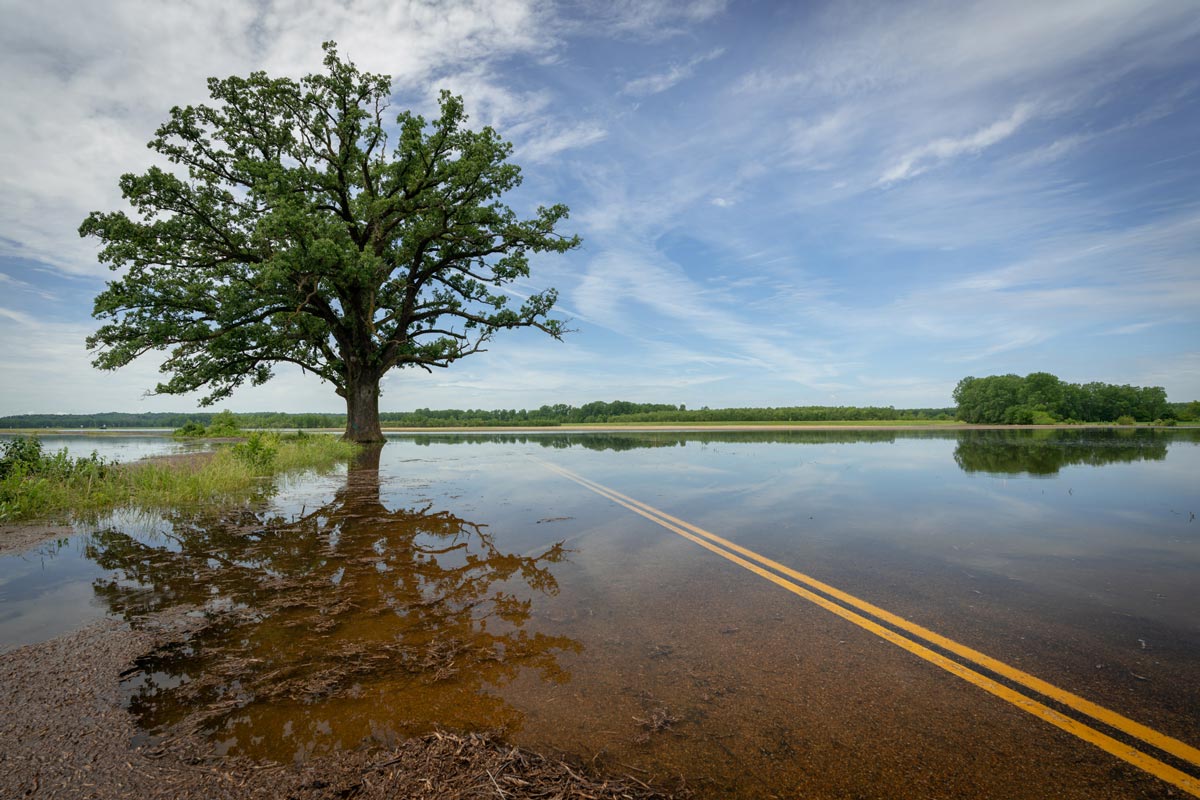This article was originally published in our January/February 2020 issue.
Missouri is home to some of the most adrenaline-pumping adventures in the nation. We’re talking about the type of adventures that are on your bucket list right next to scaling California’s Mount Whitney and skiing Jackson Hole in Wyoming. There are plenty of places to hike, bicycle, paddle, or climb in beautiful outdoor settings.
We’ve collected a handful of stories from people who have experienced the Show-Me State outdoors at its most extreme. They’ve set speed records on the Ozark Trail and scaled rock walls like the one above, located near Osceola. These tales of human versus nature are inspiring benchmarks for you to keep in mind as you plan your own adventures.
Rik Denicke, Ozark Trail
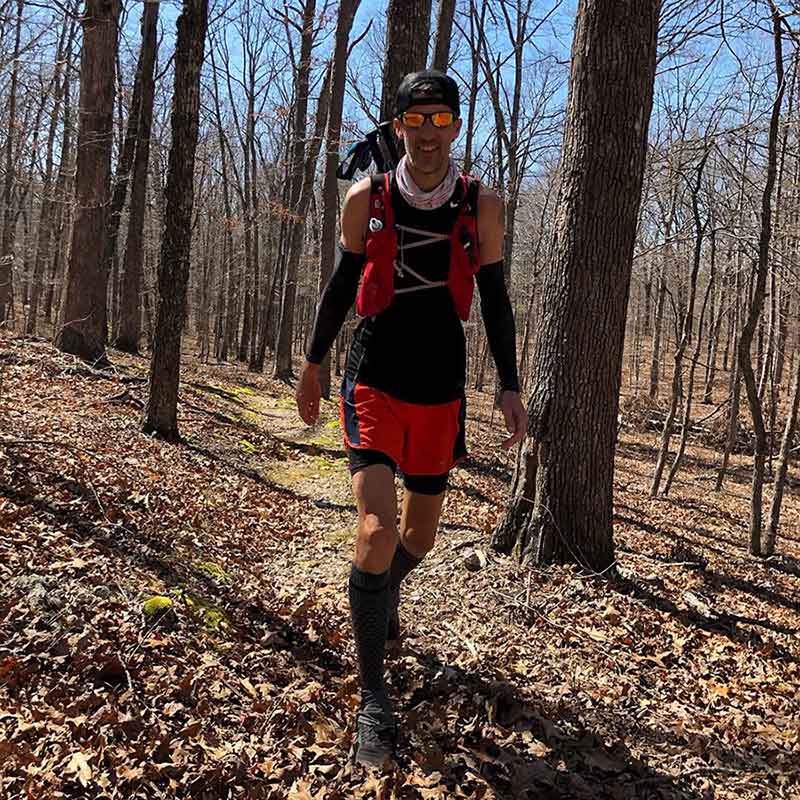
Rik Denicke doesn’t like to wonder what is left on a trail when he doesn’t complete it. In March 2019, he didn’t have to anymore. After 4 days, 11 hours, and 8 minutes, the now 47-year-old Wildwood resident became the first runner to complete a Fastest Known Time (FKT) record for a supported run on the 230-mile Ozark Trail in southern Missouri. The time stands as the only supported record logged on FastestKnownTime.com.
As an ultrarunner, Rik is used to running long distances. He’s been doing it since 2011, but the Ozark Trail presented more than its fair share of challenges during his journey.
In 2018, he made his first attempt at the FKT, but an injury made him stop after 150 miles. The heavy planning was done that year. He and his wife Shelby studied maps, planned stops, found each trailhead, and logistically planned the whole journey. In 2019, he tried again.
He began on March 26 at 5:30 AM. The weather was nice. Cold, but no rain. The trail was quiet and the early miles went smoothly. His wife Shelby and father-in-law Bob were his full-time crew who met him at stops and motivated him throughout the attempt. Like many, the beauty of Ozark Trail has always captured Rik’s attention. “I am just fascinated by the terrain and how difficult, and rugged, and really wild it is,” he says.
During the first sixty to eighty miles, blisters under his toenails began developing from accidentally kicking rocks. He had to poke underneath the nail to pop the blisters. “I literally drained my toes every single time I stopped, and it got to a point where I couldn’t run anymore because the pain was so bad,” Rik says. “Every footstep was just torture.”
He began to power hike instead. Because of the abundance of hills and creek crossings, it would have been nearly impossible to run the entire time anyway. The temperatures dropped at night to the thirties. Rik couldn’t see much during those times, but raccoons, opossums, and deer eyes were staring back at him. In the mornings, he heard turkeys calling and saw deer bounding through the Current River—a cool mist rolling over it. “There’s a lot of snapshots in my brain that really cement the whole thing and make it special,” he says.
On the third day, intermittent rain began. As night fell, it became heavier. He trudged through the rain for a couple of hours before arriving at the stop where Shelby and Bob were. He decided to take an extended sleep instead of his typical thirty minute nap. After two hours of rest, the rain was slowing, and Shelby woke him up to head back out on the trail.
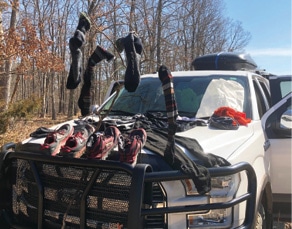
The weather on the fourth day was worse. Flash flooding and lightning began, and Rik was carrying metal trekking poles. The bridge at Courtois Creek had sixteen inches of water rushing over it, and he had to cross. “I was high stepping and I thought if I got pushed off this bridge, I would get pushed down the stream,” Rik says.
After crossing, he met up with Shelby and Bob to discuss how he would cross the same creek eight miles ahead. With the rising water and more rain coming, it seemed impossible, but you have to complete every step of the trail in order to get an FKT.
Rik was soaking wet and exhausted when he made it there. He waded into the creek as far as he could without getting swept away by the rushing water that was flowing at about three and a half times its normal rate. He knew that if he tried to get across with little sleep and no one nearby, he’d be putting his life at risk. A new plan was hatched. He backtracked and met Bob and Shelby at a trailhead he had previously passed.
He went back down to the creek from the other side—now with Shelby alongside him—and he waded into the creek to the point where he had turned around. Then, he hiked back out and was finally on the last stretch of the trail. “It couldn’t have been more intense at that time because of fatigue and how cold it was,” Rik says.
Shelby hiked the final stretch of the trail with him. Their eleven-year-old son Orion met them for the last mile, and their youngest son Keller, age six, was waiting at the end of the trail with Bob and Rik’s mom.
Rik finished the strenuous 230-mile Ozark Trail on Saturday, March 30 at 4:38 PM with only nine hours of sleep. The next day, he and Shelby were up at 7 AM to get to Keller’s soccer game.
IF YOU GO
For a day hike on the Ozark Trail, you’ll need to bring along the essentials. Water, snacks, a phone, GPS or map, a first aid kit, hiking shoes, and a friend to tag along if you don’t want to explore the wilderness alone. All levels of hikers can experience a short hike on the trail. But if you’re interested in attempting an FKT on the entire trail, you’re going to need a lot more than that. “The actual undertaking of a run like this includes so much prep and planning that most people would never think about,” Shelby says.
Shelby and Rik planned every detail of the trip beforehand, and that was just the beginning. In addition to the full-time crew who followed along on the journey, he also had pacers (other people running alongside him for select stretches, keeping him on pace), food, water, a GPS tracker, headlamps, trekking poles, twelve pairs of shoes, outfits for all types of weather, and significant experience in running and hiking.
Chuck McHenry, St. Francis River
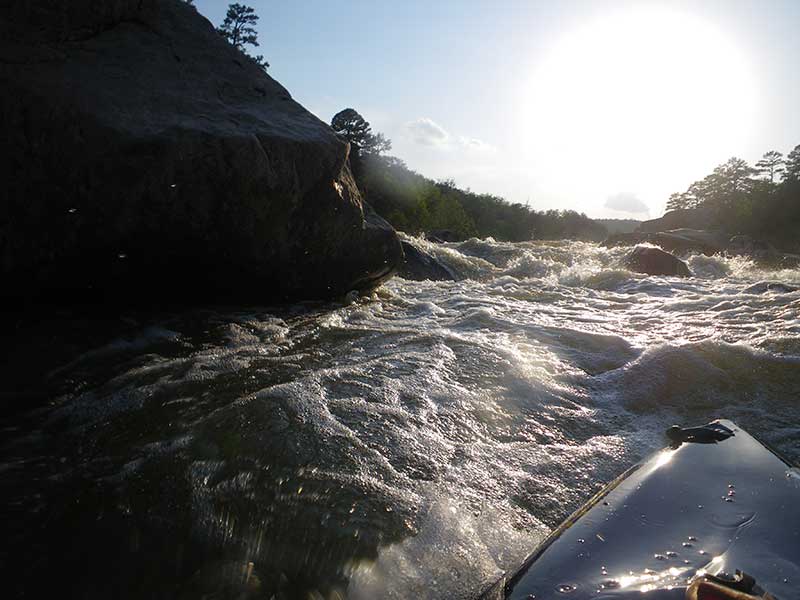
The Great Flood of 1993 was one of the worst river floods in Missouri history. The mouth of the St. Francis flows into the Mississippi, and the St. Francis was roughly twenty-seven feet high. Chuck McHenry, a retired dentist at Ironton, was on the upper part of the river with friends.
When they got to the lower part that starts at Millstream Gardens and is significantly more difficult to paddle, he wanted to continue, but his friends did not, so they all got out of the river and headed home. He couldn’t help but feel as though he passed up a unique opportunity. “I promised myself if the river ever came up to that level again that I was going to go even if I had to go solo,” Chuck says.
Then in April 2018, the river came up to twenty-seven feet again. Twenty-five years after the Flood of ’93, Chuck had his chance at redemption. At sixty-seven years old, he was the first person (as far as anyone knows) to kayak down the middle of the lower St. Francis River when it was that high.
The seasoned kayaker knows his way around the Saint, as locals call it, but this attempt presented a unique challenge. Five months prior, Chuck had undergone shoulder surgery and wasn’t supposed to kayak for a full year, but he felt he couldn’t pass up the opportunity a second time.
Two other paddlers, Cody Maple and Alex Fleischut, offered to be his safety during the journey. They went down the side of the river and tried to keep an eye on Chuck while he went straight down the middle.
He made it over the first wave successfully. “I remember going into the trough and looking up and thinking, ‘Oh my gosh, this wave is huge,’ ” he says. “I went over it, but the water sprayed me and my glasses fogged up, so I was having trouble seeing.” He couldn’t take his hands off of the paddle to wipe his glasses because the water was too violent.
The second wave turned him upside down in his kayak. His onside roll didn’t flip him back over because of the injury. Luckily, his offside roll worked. “I have to admit, I was a little woozy after that,” Chuck says.
Chuck has run the river approximately 3,500 days at all different levels. As an ACA-certified instructor, he has taught many others how to kayak, too. One of those people was his friend Doug Hendrickson, also known as Doc Iron, who passed away from Lou Gehrig’s disease in 2007. At his funeral, some of his ashes were left with Chuck.
“What he said was that he never got good enough to do the river at ten feet over [the Silver Mines bridge], which is a very significant level, and he said he always wanted to,” Chuck says.
He wanted Chuck to take him down the river one last time. So Chuck did just that. He waited until the river was ten feet over the Silver Mines bridge that kayakers use to measure the water level on the river, and he tied the unfired clay pot that held Doc Iron’s ashes to the stern of his kayak and showed his friend what the Saint was like at that level.
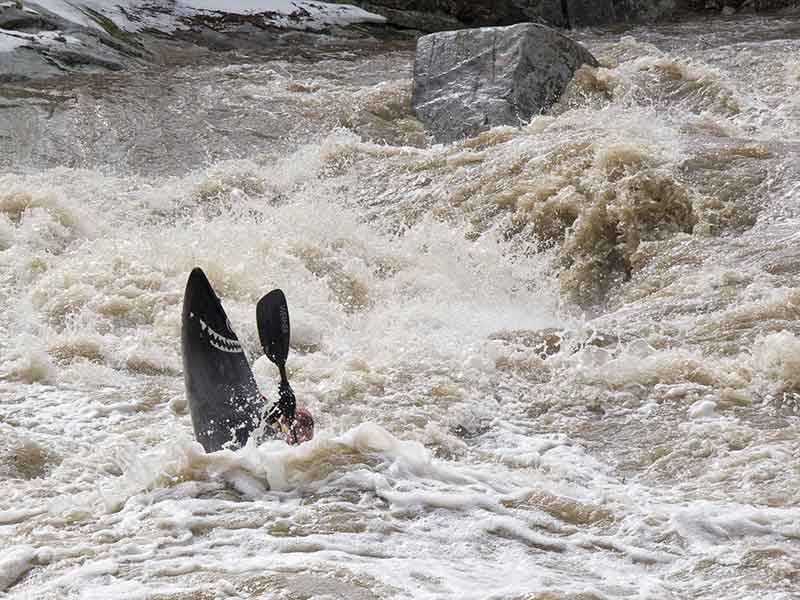
“There’s probably only six or seven people in the state that would do the river at ten feet over, and two of them showed up and helped me,” Chuck says. When Chuck completed his 2018 run, the river was an additional thirteen feet higher.
Slim Olsen and Pete Larsen are the two high-water veterans who joined Chuck. That run is now known as the Doc Iron Memorial Float.
Now at sixty-eight years old, Chuck and his wife Diane still find plenty of time to be on the water. In fact, Diane is the only person who’s been in every regularly scheduled MR340 race.
IF YOU GO
There’s a reason Chuck is the only person to ever successfully run the river at the depth it hit in 2018. Most people simply aren’t going to be equipped for whitewater kayaking at that level. But if you’re looking for something beyond the typical float, the Missouri Whitewater Association teaches all levels of kayaking and will prepare you for kayaking on rivers like the St. Francis. They also host a clinic every April to teach kayakers with all different experience levels.
When whitewater kayaking, Chuck says having your roll down is the most important requirement. “That means if you flip over, there’s no doubt that you’re going to bring the boat back up,” he says. Kayakers also pad their boats so there is no room between them and the side. If they flip, they won’t fall out. “You have to be calm and collected,” Chuck says. “If you’re nervous, that’s not the place to be.” When whitewater kayaking at any level, you need a life jacket, helmet, spray skirt, dry suit, dry bag, paddle, and someone to be your safety.
Adrienne Taren, Bikepacking

The Katy Trail is heaven for some cyclists. Some are trying to see how fast they can go on the trail, while others are just enjoying the ride. Adrienne Taren from Tulsa, Oklahoma, was somewhere in between the two.
On her vacation in October 2018, she bikepacked a little under four hundred miles round trip in two and a half days on the trail. Her bike weighed forty pounds with essential gear packed onto the frame.
“I think part of what drives a lot of people to off road is to see what you can do self-supported, and there’s an additional challenge of being self-
sufficient,” Adrienne says.
She parked her car in Pleasant Hill and unloaded her bike to begin her journey. This is where the western end of the Rock Island Spur branch of the Katy Trail begins. After fifty miles, she made it to Windsor where the Rock Island Spur branch intersects the main Katy Trail.
At the intersection, she got disoriented and headed west toward Clinton. After she discovered her mistake and turned around, she biked east toward Sedalia. It was lightly raining, but it wasn’t a huge deal to her. She had raced in a thunderstorm three days earlier, so this was light in comparison. But then a torrential downpour began. Within ten minutes, she was soaked. She turned around once more and went back to Windsor to find refuge at a motel.
“I will totally camp in the rain, but I was already soaked,” Adrienne says.
She traveled right around seventy miles that day. At the motel, she was setting her soaking wet clothes out to air dry when the manager knocked on her door and offered to dry her clothes. A couple of other soaking wet people had shown up, too. Small-town hospitality never fails.
She left the motel around 8:30 the next morning and made her first stop of the day at Casey’s General Store. After fueling up on coffee and Hershey’s, she was back on the trail. Luckily the rain was over for the week.
Another one of her stops was at the Clifton City trailhead where she ran into two other bikers from opposite sides of the US who meet up once a year for a cycling trip. “Meeting people and interacting with people is part of the appeal,” she says.
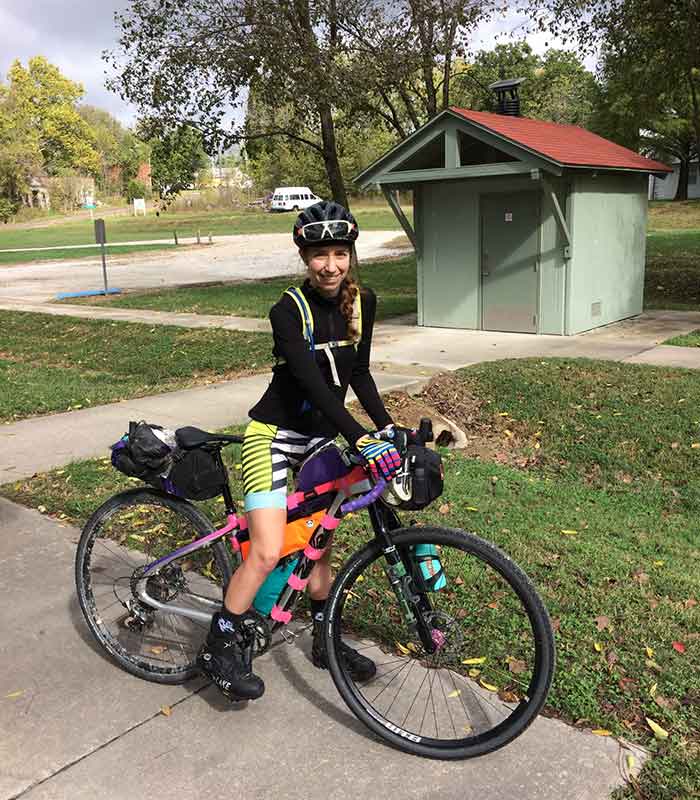
They’re the ones who told her about the Turner Katy Trail Shelter at Tebbets, a home filled with bunk beds specifically for riders. So she decided that’s where she’d stay; it cost only six dollars for the night. She completed 128 miles that day.
The next morning, on day three, she was back on the trail, traveling west for her return journey, by 5:30 AM. She biked eighty miles before making her first stop, another Casey’s. “Gas station food and coffee never tasted so good,” Adrienne says.
When she made it back to Windsor, she double checked to make sure she wouldn’t make the same mistake twice by going the wrong way. She had about fifty miles to go. “It becomes meditative after a while.” Adrienne says.
She made it back to Pleasant Hill in the evening and rode back to her car. Her journey on the Katy Trail was complete; now all that was left to do was to drive home to Oklahoma.
IF YOU GO
While bikepacking, your bike should be able to carry everything you need. Here’s what Adrienne packed:
Frame bag (Rogue Panda): Headlamp, three headlights, charging cables, four battery packs for headlamp, iPhone charger, dry bag with second pair of socks, hand warmers, and mittens.
Side pocket: Map, small bottle of chain lube, spare AAA batteries, Dynaplug, spork, pepper spray, and pocket knife.
Front roll: Nemo GoGo bivouac in Sea to Summit dry bag, under a Wanderlust pinon pack holding additional snacks, toothbrush, toothpaste, contacts, and sunscreen.
Seat pack: Tools/spare tubes, Otto lock, sleeping pad, Enlightened Equipment Revelation quilt, Patagonia puffy coat, running shorts, and Gore rain coat.
Top tube bag: Huppy bars, Lara bars, Justin’s almond butter, and emergency gummy bears.
Your gear and supplies should look similar during your bikepacking trip. “You have to be pretty self-sufficient.” Adrienne says. “Being able to fix everything on your bike is super important.”
Rusty and Amber Coons, MR340
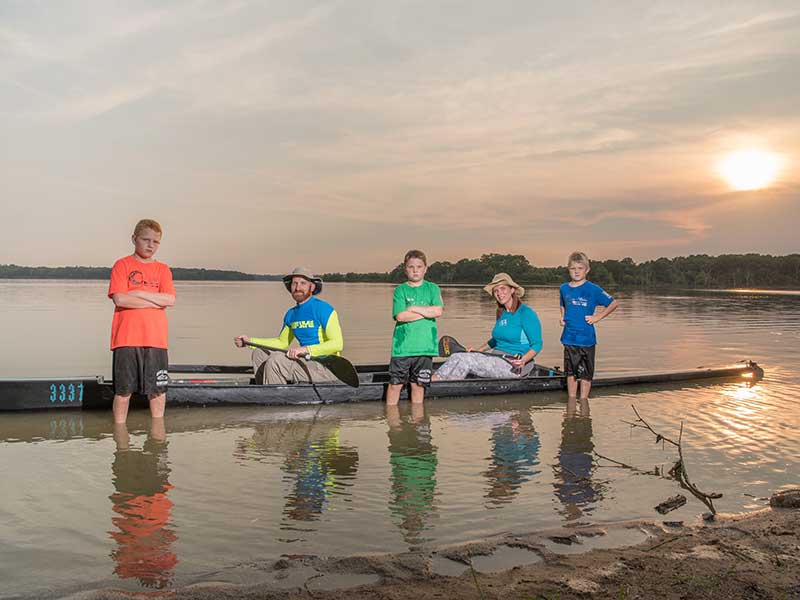
For most, the annual MR340 race is a grueling experience or something to check off of their bucket list, but for Rusty and Amber Coons, it’s a family tradition.
Rusty was the first one in the family to show interest in the tough 340-mile race down the Big Muddy. His first year racing was in 2012 with his brother Joe. Amber swore she would never participate. Until she did. In 2015, she and Rusty loaded up a canoe and made their journey down the river for the first time together.
This was the same year Rusty had the most finishers in one family. Five. “I pretty much conned everyone into it at this point,” he says. His brother Dan also made history in 2015. He completed the race in a solo kayak, and he was the first person with multiple sclerosis to ever do so.
Fast forward to 2017, Amber and Rusty were on the Missouri River racing together again. This time in a homemade outrigger canoe that was built by fellow racer Matt Green. They finished second in mixed tandem. Their oldest son, Ryder, and Rusty’s mom, Diana Slater, were their ground crew during this race.
It was one of the smoother years, but like with any MR340, there were still challenges. They had to go through a debris field in the river that was filled with old headlights, gas cans, and other items that didn’t belong there. “That was probably our scariest moment because we hadn’t put the boat through its paces to know what it could handle as far as damage,” Rusty says.
Despite the challenges, they keep coming back.
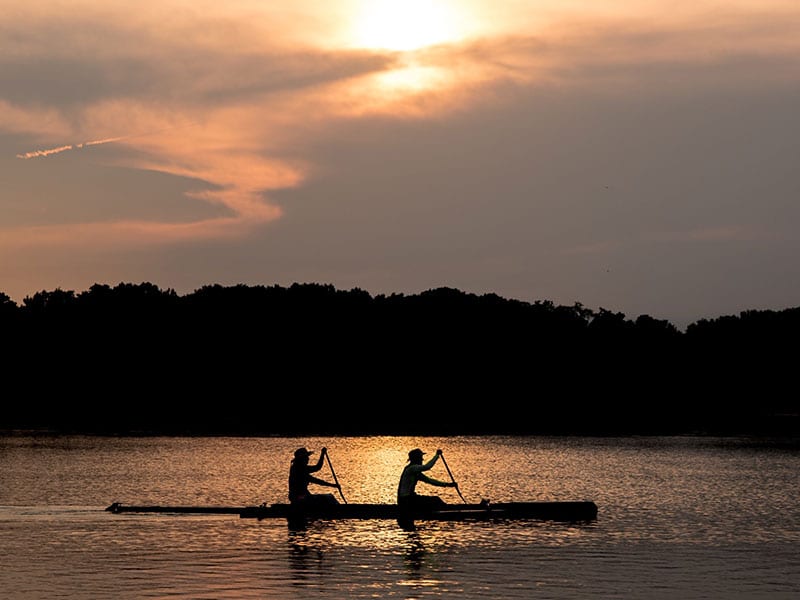
“We’ve met some good friends, and they’re good people,” Amber says. “I think it’s a great community to raise your kids in and to learn from each other.”
Diana and all three of Rusty and Amber’s children were waiting for them at the finish line in 2017.
“You get pretty emotional toward the end,” Amber says. You’re exhausted and just knowing that all three of them were there at the finish, it was pretty cool and you get some tears to your eyes just hearing their little voices carry across the water cheering Mom and Dad in.”
In 2019, their middle son, Grady, eleven, was planning on participating in his first race but flooding and extremely cold weather caused the race to be postponed until November, when it was too cold for all but four racers.
Diana was as disappointed they didn’t get to race last year as he and Amber were, Rusty says. “It’s a big deal for our whole family.”
Diana has been a part of Rusty’s ground crew since he began racing and has played a pivotal role in his family’s success.
“The awesome thing that she does is she’s at every boat ramp no matter what,” Amber says. “Whether we’re stopping or not, she goes to every boat ramp to get a visual on us, and I make sure to put the kids in bright colors so I can see them on the banks.”
They couldn’t race in 2019, but they’re hoping for a better 2020 race with their son in a boat, too.
“I don’t know what happens in that race, but when you get to the finish line, a lot of that misery falls right off and you feel so much better. You’re ready to do it again,” Rusty says. “At least we are.”
IF YOU GO
The MR340 is the longest nonstop river race in the world that river rats and newbies alike love to participate in. While some are quite literally in it to win it, there are also people who enjoy taking their time and meeting people along the way.
If you’re more interested in the experience rather than a trophy, a day of casual paddling might be more up your alley. There are plenty of good stretches on the Big Muddy for that kind of excursion. Bring along your life jacket, sunscreen, water, and a dry bag. You should also be prepared to encounter barges and know how to navigate when you see one.
Jon Richard, Rock Climbing
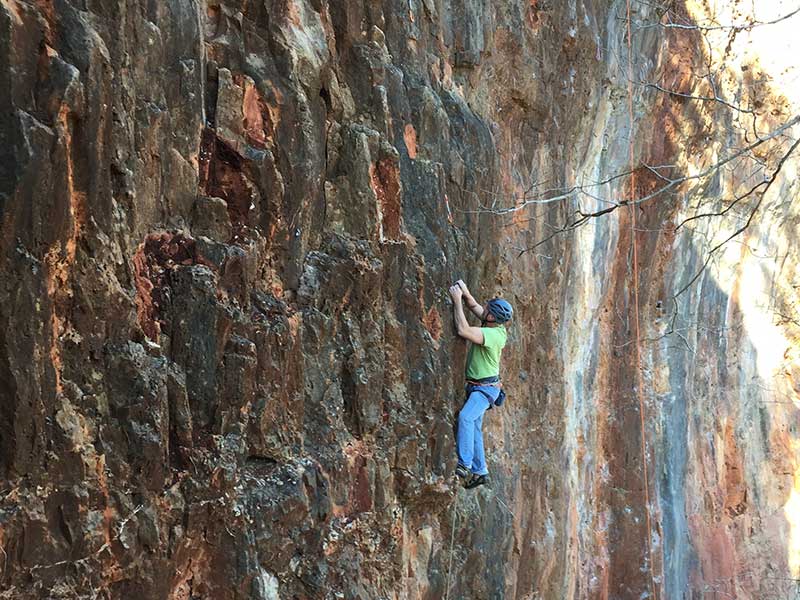
Okay sure, Missouri isn’t the first state that comes to mind when you hear “rock climbing.” But the Show-Me State shouldn’t be left out of the conversation. “We view the Midwest as kind of the ultimate training grounds,” says Jon Richard, owner of Vertical Voyages in St. Louis. Missouri can help climbers prepare for longer and tougher journeys in the future.
Jon started climbing in 1995 and made it his full-time career in 2009 when he opened his climbing guide service. Since then, he has offered rock climbing programs, canopy climbs, and mental fitness training for climbers who have hit a plateau or are experiencing fear, and he trains arborists to help them develop better climbing techniques.
“I’ve really had to diversify quite a bit, but on the same token, I don’t apologize for climbing in Missouri,” Jon says.
Robinson Bluff near Washington State Park, about sixty miles south of St. Louis, is Jon’s and many local climbers’ favorite spot in Missouri. It sits right above the Big River. Jim Thurmond and his wife, Nicky, found Robinson Bluff in 1995 when it was privately owned. He made Bill Weishaar, a fellow climber, aware of its existence in 2016 when it was for sale. Bill and his two brothers, James and Chris, purchased the bluff in 2017, and it’s now open to the public.
With 3,600 feet of bolted routes and 3,500 feet of bluff line, it offers a challenging climb, and it’s not just challenging for Missouri.
“It’s a really tall bluff and honestly the movement and the climb are on par with anywhere and any single thing in the country,” Jon says.
Jon has climbed all over the world, including the nose of El Capitan in California, the French Alps, and in northwest Arkansas during a twenty-four-hour climbing competition. “It’s like a different dimension when you get up on a rock wall. I think particularly what surprises people is that I don’t do it for any type of adrenaline rush. I do it to relax,” Jon says. “It focuses your mind.”
The canopy climbs he offers have become popular in the St. Louis area. Since most outdoor climbs are at least an hour away from the city, Jon wanted to offer something closer to home so more people could experience the activity. Canopy climbs are done at places like the Missouri Botanical Garden in St. Louis and the Wyman Center in Eureka. At the latter location, a family from southern California traveled to the Eureka location for one night only so they could camp in a tree.
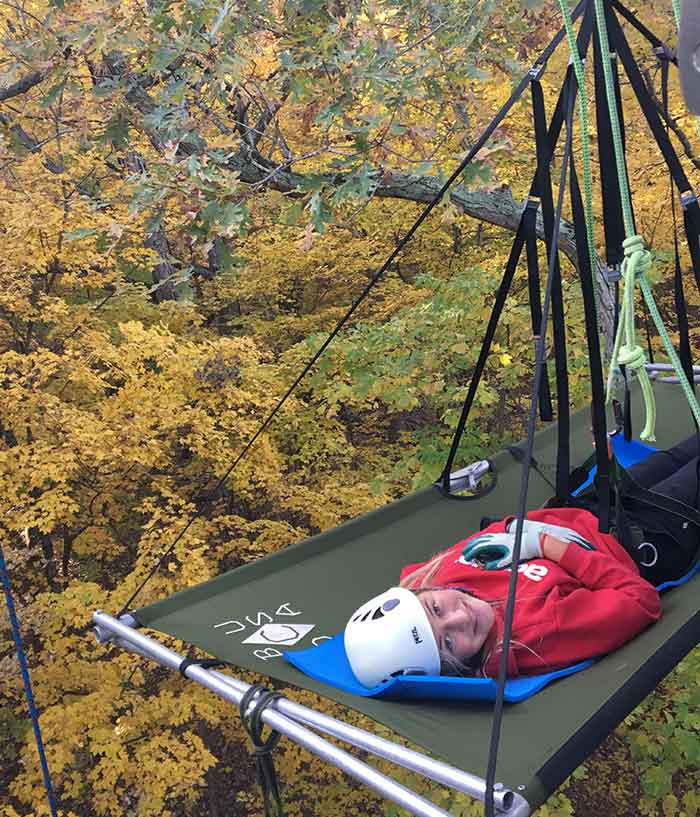
There are a handful of indoor climbing companies in St. Louis, but Jon wants people to know about the outdoor climbing opportunities, too. “I think the Midwest is a good place to develop some real skill and be able to have a lifelong hobby of going climbing all over,” Jon says.
He knows there are tougher climbs and taller rock walls around the world, but that doesn’t mean the rock walls in Missouri are something to scoff at either.
“You don’t have to go to Colorado to have an adventure. And you don’t have to think of your adventures here in the Midwest as substandard.” Jon says. “They’re true adventures.”
IF YOU GO
Vertical Voyages teaches all levels of climbers and provides all equipment necessary to climbers. Robinson Bluff is one of the best places in Missouri to perfect your craft, but if you’re a beginner, you can practice at indoor rock climbing gyms across the state like Zenith Climbing Center in Springfield or Climb So iLL in St. Louis. If you’re looking for a different type of adventure, the company also offers canopy climbs in the St. Louis area.
Main photo // Andrew Burr
Related Posts
Missouri River Days hosts fourth graders
Missouri River Relief is hosting Missouri River Days for the first time since 2019. This program provides fourth-graders from Columbia Public Schools with a field trip to the Missouri River, where they will get to experience its muddy waters aboard one of Missouri River Relief’s motorboats.
Missouri Plein Artist Billyo O’Donnell Shares His Art
Meet the Missouri plein air artist who translates with paint.
Notley Hawkins Documents the Flooding in Mid-Missouri
Photographer Notley Hawkins captured images of the historic flooding in mid-Missouri with his camera and drone. Plus, learn how you can assist in relief efforts.



